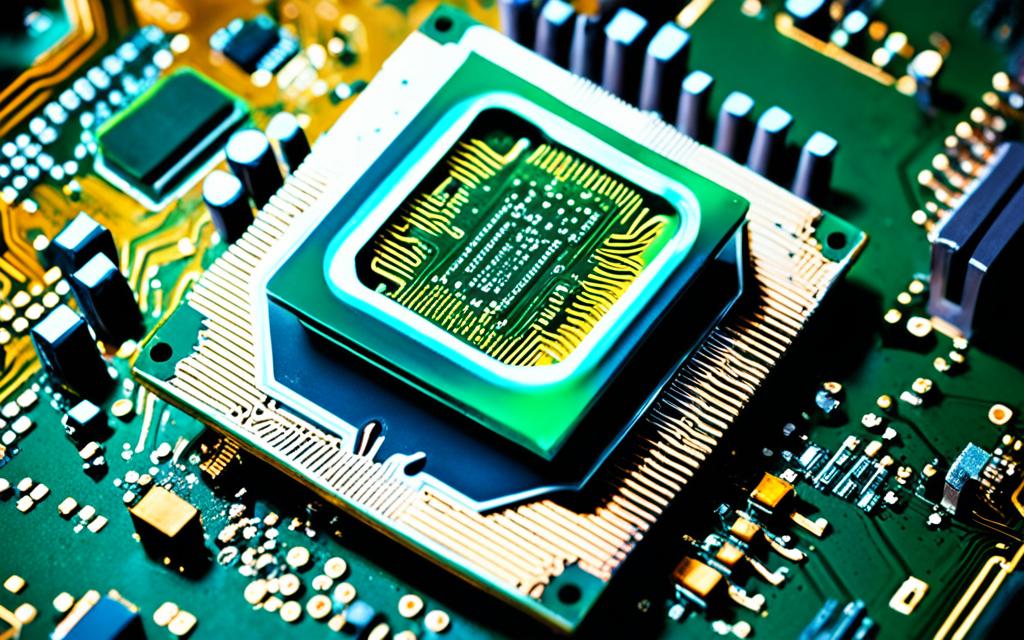Table of Contents
The Central Processing Unit (CPU) acts like your computer’s brain. Like all parts, it can wear out over time. CPU failure signs show your computer might not last much longer. Knowing these dying CPU indicators helps prevent crashes and saves your data. Signs of trouble include random shutdowns and errors that stop your work. High heat over long periods often causes CPU damage, marked by1. Spotting these early lets you fix issues before they worsen. It’s key to know when your CPU needs help.
Key Takeaways
- Common symptoms of a dying CPU include computer freezes, slow boot times, and error messages.
- Overclocking can significantly shorten CPU lifespan and lead to failure.
- Power surges from outages or storms can cause irreversible damage.
- Faulty motherboards can make CPU problems worse by mishandling electricity.
- Keeping an eye on your CPU’s health can catch issues early on.
Signs of a Dying CPU
Knowing the signs of a dying CPU helps keep your system running well. It’s key to check for common CPU failure symptoms regularly. This can prevent data loss and hardware issues. This section will show how to spot these signs and understand warning messages.
Understanding Common Symptoms
Several signs may suggest your CPU is failing. Frequent blue screens with a specific error code hint at CPU issues. You might also hear 5-7 beeps during startup, which is bad news for the CPU2.
Random shutdowns and system freezes are other signs. If your mouse stops working suddenly, it’s a hint too3. Look for physical signs like burn marks near the CPU socket. These often lead to overheating that harms your CPU1.
Recognising Error Messages
Error messages play a big role in spotting trouble. They can pop up at startup or while you’re using the computer. If you see these warnings a lot, your hardware might be failing. Trouble starting, a blank screen, or a silent PC signal big trouble2.
If your computer keeps rebooting with these warnings, it’s a serious sign. It could mean your CPU has failed and needs quick action3.
| Symptoms | Potential Causes | Recommendations |
|---|---|---|
| Frequent BSOD | Overheating, hardware failure | Check system temperatures regularly |
| Unresponsive System | Malfunctioning CPU | Perform diagnostics, test with another PC |
| Unexpected Shutdowns | CPU overheating | Ensure proper airflow and clean dust buildup |
| Beeping during POST | Potential CPU failure | Inspect motherboard connections and re-seat CPU |
Random Shutdowns and Its Implications
It’s really annoying when your CPU suddenly shuts down and you don’t know why. Tackling these sudden stops is key for a smooth computing experience. There are many reasons for this problem, like overheating or part failures. Knowing why and solving it can prevent more trouble and improve your computer’s work.
Potential Causes and Solutions
Random shutdowns could come from different problems. Overheating is common, especially if your CPU’s temperature goes over 60℃. It shuts down on its own to avoid damage4. Laptops get too hot more easily than desktops because of their size and cooling issues4. If it’s getting too hot, you might need to clean out the dust blocking the air or update your cooling method. You may have to put in new thermal paste or get a better cooling system.
Bad drivers can also cause your computer to turn off by itself. Keeping your system updated, like with Windows 10, helps you get the newest driver versions and may fix the shutdown issue4. Shutting down could be because of viruses too, which you can often spot and handle with antivirus checks. Problems after updating your operating system might also make your computer unstable; correct updates and settings should avoid these problems4.
The Role of Overheating in Shutdowns
Overheating plays a big role in why CPUs randomly shut down. If your CPU gets too hot, it puts a lot of stress on its parts. This can hurt the computer’s work and lifespan. Keep your computer’s surroundings well-aired, fans clean, and heat moving away well to make your CPU last longer4. Looking at how your device, like an i7 760m, behaves can help. For example, if it hits the mid-60s ℃ on easy tasks, it might overheat with heavy use5.
By taking care of your computer regularly, you can lower the chances of unexpected shutdowns. Through updates and keeping your computer cool, your system will be more stable and dependable.
Startup Issues that Signal Problems
Spotting problems early is key to keeping your computer running well. Such troubles often point to deeper issues with the hardware or software. Fixing these issues early helps stop worse damage and keeps your computer working smoothly.
Decoding BIOS Error Messages
Seeing BIOS error messages when you start up is a clue that something’s wrong. These messages mean the system found a hardware problem during its checks. Understanding these error codes helps you find out what’s wrong faster.
For example, if it’s a RAM or hard drive issue, checking their connections might solve the problem. Facing a message? Note the error code and look it up. This step is crucial for fixing CPU issues quickly6.
Diagnosing Hardware versus Software Errors
Distinguishing between hardware and software problems at startup is essential. At first, boot failures might seem like software issues. But, if problems keep happening, it might mean your CPU is dying and needs fixing or replacing.
Doing a thorough check of both hardware and software can pinpoint the problem. Using tools to check your CPU’s temperature, like this guide, helps. Overheating is a common CPU issue, causing crashes or shutdowns. Remember, everything from your power supply to your hard drive affects startup7.
https://www.youtube.com/watch?v=W4n4Wwmm7MA
| Issue Type | Typical Cause | Diagnostic Approach |
|---|---|---|
| Power Issues | Failing Power Supply | Check cables and PSU functionality |
| Boot Failure | Corrupted System Files | Use recovery tools or Safe Mode |
| Hardware Errors | Improperly Seated Components | Reseat RAM and graphics card |
| Temperature Problems | Overheating Components | Monitor temperatures and improve airflow |
| Driver Conflicts | Outdated or Corrupted Drivers | Update drivers or roll back recent updates |
Power Problems and Their Effects
Knowing how power supply stability and CPU performance link is key for a good computer setup. When power problems occur, they can cause big issues for operation. It’s important to spot and fix faulty parts first.
Identifying Faulty Components
If a computer doesn’t start, it might mean there’s a big problem with the CPU power or power supply. Lights that flicker or dim can hint at a failing power supply. Random shutdowns could mean the voltage is too low, hurting the system’s stability and how well it works8. It’s good to check LED lights and look for capacitors that are swollen or leaking. These can show your power source may be failing. If error messages keep popping up when the computer starts, you should check the power supply9.
The Importance of a Stable Power Supply
For a CPU to work well, it needs a stable power supply. Power ups and downs can damage the CPU and other parts a lot8. If the power keeps changing, your computer might crash randomly or not start at all. Using surge protectors can help keep your CPU safe from electrical problems. This helps your CPU last longer and makes sure your system works well10.
How to Tell if CPU is Dying
It’s crucial to check how your CPU is performing to know if it’s about to fail. Watch out for signs like high CPU temperature, high use rates, and more errors. Keeping an eye on these signs helps you act early if things go bad. You can use specific software to track these metrics. This lets you spot problems that might mean your CPU is failing111.
Key Performance Metrics to Watch
Keep an eye on your CPU’s temperature. Too much heat often means trouble and might come from bad heatsinks or not enough air flow1. Also, if your CPU is always busy but isn’t cooled properly, it might get damaged over time1. Watch out for more errors or if your computer starts acting weirdly. These are warning signs that need quick action to stop bigger problems11.
FAQ
What are the common signs of a dying CPU?
Erratic behaviour, unexpected shutdowns, and frequent blue screens are common signs. Miscoloured pixels and system freezing also signal CPU issues. Recognising these early can help.
Keep an eye out for error messages that mention hardware or drivers. These are often critical signs of CPU problems. It’s important to act on them to keep your system running smoothly.
1>
Q: What causes random shutdowns in computers?
Random shutdowns can stem from many issues, like faulty parts, overheating, or power supply problems. Running hardware diagnostics can pinpoint these random shutdown causes.
How does overheating affect CPU performance?
Overheating can seriously harm your CPU and other parts. To prevent damage, improve air flow, clean fans, and ensure you have adequate cooling. These steps extend your CPU’s life.
What should I do if I see BIOS error messages at startup?
BIOS error messages hint at hardware issues detected during POST. Learning these codes is crucial as they often point to CPU problems needing attention.
How can I distinguish between hardware and software errors during startup?
Performing detailed diagnostics is key to pinpointing startup issues. Software problems can cause startup hiccups, but ongoing troubles may suggest a failing CPU that needs replacing.
How can I identify faulty components in my computer?
Check connections, cables, and the CPU performance if your computer doesn’t respond. This approach helps find the component that’s not working correctly.
Why is a stable power supply crucial for my CPU?
A consistent power supply prevents damage from power fluctuations or surges. Using surge protectors protects your CPU and extends its lifespan.
What performance metrics should I monitor for my CPU?
Monitor your CPU’s temperature, utilisation, and error rates closely. Watching these metrics helps catch and address problems early, ensuring your CPU runs well.
Source Links
- https://techfident.co.uk/how-do-you-know-if-your-cpu-is-dying/ – How Do You Know If Your CPU Is Dying? – Techfident
- https://computingaustralia.com.au/understanding-cpu-processor-failure-symptoms/ – Understanding CPU (Processor) Failure Symptoms
- https://www.pcguide.com/cpu/how-to/tell-is-failing-or-dead/ – How to tell if your CPU is failing or dead – 7 signs to look for
- https://www.mainstreetitsolutions.com/8-reasons-pc-keeps-shutting-randomly/ – 8 Reasons for PC Random Shutdowns – MainStreet IT
- https://forums.tomshardware.com/threads/can-faulty-a-cpu-cause-random-shutdowns.3750015/ – Question – Can faulty a CPU cause random shutdowns?
- https://www.pcmag.com/how-to/what-to-do-when-computer-wont-start – Not Dead Yet: What to Do When Your Computer Won’t Start
- https://gadgetmates.com/troubleshooting-common-cpu-issues – Troubleshooting Common CPU Issues: Quick Fixes and Expert Tips – GadgetMates
- https://www.bravoelectro.com/blog/post/bad-power-supply-symptoms – Bad Power Supply Symptoms: How to Tell When Your Unit is Failing | Bravo Electro
- https://www.ituonline.com/blogs/cpu-problems/ – Troubleshoot Computer Hardware Problems : CPU Problems – ITU Online
- https://forums.tomshardware.com/threads/how-to-tell-if-your-cpu-or-motherboard-is-bad.386222/ – How to tell if your Cpu or motherboard is bad
- https://www.makeuseof.com/signs-your-motherboard-is-dead/ – 8 Signs Your Motherboard Is Dead








